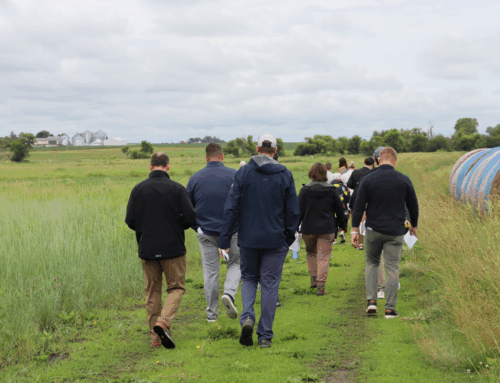Great Outdoors Foundation CEO Issues Open Letter Regarding Central Iowa Water Works Usage Reduction Plan

DES MOINES, IA (June 17, 2025) – Given the Great Outdoors Foundation’s (GOF) role in the conservation sector, I wanted to provide some insight and context around the current water usage reduction plan from Central Iowa Water Works. Typically, spring rains flush nitrogen through our waterways. Because of the drought over the last few years, there is likely a buildup of latent nitrogen within the watershed. This, coupled with late spring rains, combined for sustained historic levels of nitrogen within our waterways with elevated levels for several concurrent days. Because of the timing of rain, this also coincided with increased water usage of summer recreation and lawn irrigation. For reference, the latest nitrate levels are 15.11 mg/L in the Raccoon and 14.77 mg/L in the Des Moines. EPA standard is 10 mg/L.
Central Iowa Water Works’ nitrate removal facility can only treat 10 million gallons a day to help blend down the nitrate level of finished water so that it complies with EPA standards. Foreseeing this issue, Central Iowa Water Works issued a voluntary lawn watering reduction of 25 percent last month. They increased that to 50 percent on June 11. They did not see the reduction needed to provide safe water for the metro. Thus, the ban was introduced late last week. There has been a 30% reduction in water usage since the ban went into effect. The current situation is trending in the right direction; however, that does not negate the need for system-wide reform on how we address water quality in Iowa.
The conventional model of conservation is antiquated, receiving no major reform since the original iterations of the Farm Bill in the 1930s. We need to modernize the delivery system for conservation to provide farmers and landowners with viable opportunities to invest in land and water. Cumbersome red tape and funding sources make accessing cost-share programs incredibly burdensome, ultimately creating barriers to value-driven decision-making. Farmers and landowners want to invest in conservation; however, high-impact infrastructure often can’t be activated by a single individual. In fact, GOF and its partners are aware of more than $150 million worth of voluntary conservation infrastructure, just waiting to be funded. Those dollars represent hundreds of willing, often enthusiastic, farmers and landowners who want to play an active role in positively impacting Iowa’s waterways.
The crisis around nitrate levels in our waterways isn’t unexpected, in fact, GOF and its partners have been working for years to mitigate it and other harmful inputs by advancing water quality initiatives across the state. That’s why several years ago, GOF launched the Conservation Acceleration Fund (CAF), a dynamic funding mechanism designed to create exponential growth in water quality investments.
The CAF’s 2024 projects activated more than $28 million in water quality investments and will mitigate 1.2 million pounds of nitrate from Iowa’s waterways. It has a proven track record of success that can act as a model for additional efforts. Now is the time for urban, rural, public, and private stakeholders to build a coalition and enact meaningful change. Immediate actions can be taken to increase conservation funding, efficiency, and implementation while simultaneously removing barriers and stigma. Our recommendations to our partners are as follows:
- Developing a cross-sector, public-private task force that will oversee continued water quality efforts on behalf of Central Iowa Water Works, Polk County and the state at large.
- Advocating for the funding of IWILL, legislation that has had the support of Iowans for the last two decades.
- Creating efficiencies in implementation by investing in and partnering with NGOs working in the conservation and water quality space.
- Removing barriers and administrative red tape that inhibit the adoption of vital conservation practices by landowners.
- Supporting legislative changes at the federal level to enable additional conservation planners that can increase the pace of project implementation, specifically allowing more conservation planners to expedite projects through funnel.
- Creating a state-led funding mechanism for long-term operations and maintenance.
We are continuing to work with all partners to address the acute and long-term needs. Yes, there’s a problem; yes, we’re making improvements; yes, more needs to be done to make the necessary changes at scale.
![]()
Hannah Inman, CEO
Conservation Acceleration Fund Partners & Investors
- Agriculture’s Clean Water Alliance
- Athene
- CoBank
- Community Foundation of Greater Des
Moines - Drake University
- Heartland Co-Op
- Iowa Agriculture Water Alliance
- Iowa Department of Agriculture & Land Stewardship
- Iowa Department of Natural Resources
- Iowa Economic Development Authority
- Iowa Finance Authority
- Iowa Lakeside Lab
- Iowa Natural Heritage Foundation
- Iowa Nutrient Research & Education Council
- Iowa Soybean Association
- Iowa Stormwater Education Partnership
- ISG
- ITA Group
- Prairie Meadows
- Principal Financial Group
- Polk County
- Polk County Conservation
- Walton Family Foundation
About the Great Outdoors Foundation
The Great Outdoors Foundation exists to advance conservation through innovation, collaboration, and stewardship. We are the foremost fundraising professionals in the conservation and outdoor recreation sector. Together, we activate meaningful, accessible initiatives that enhance our environment and improve quality of life. Over the last few years, we have invested more than $200 million in conservation and outdoor recreation initiatives, and we’re just getting started.

